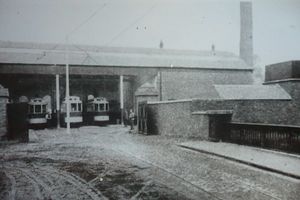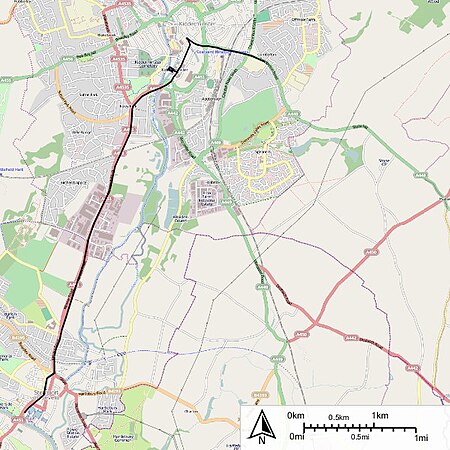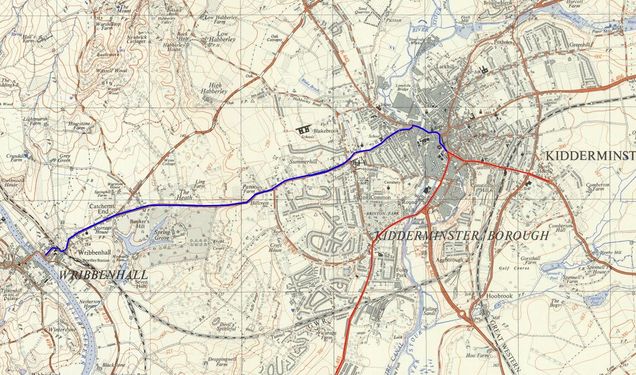Kidderminster and Stourport Electric Tramway
The Kidderminster and Stourport Electric Tramway ran between the two named towns as an isolated subsidiary of the Birmingham and Midland Tramways, which was itself owned by the British Electric Traction Company Ltd.
Construction work began in 1897 and was undertaken by the local company George Law of Comberton Hill,[1] who also built the Bridgnorth Cliff Railway and many years later would build The Engine House for the SVR. The tramway was built to a gauge of 3'6" and subject to a speed limit of 5mph in town and 12mph in open country.[2] Unusually for a tramway, the majority of the main line outside the urban areas was on sleeper track at the side of the road.[3]
Services were advertised to begin on Monday 23 May 1898, although a last minute decision that more test running was required meant that passengers were not carried until Wednesday 25 May 1898.[4] Traffic levels peaked in 1908,[5] after which a slow decline took place up the the First World War. The decline continued after the War, and the last tram ran on the short Comberton Hill route on 31 December 1923, after which time they were replaced by buses. Services to Stourport continued, but by 1928 the tramway Company was seeking permission from the Ministry of Transport to close the tramway altogether, as competition from buses meant they could not raise the necessary capital to maintain and upgrade the route. While MoT permission was still awaited, services ended unannounced on 2 April 1929 with a 'temporary' bus replacement service being instituted. The closure became official later that month[6].
Contents
Competition with the GWR
From its introduction, the tram service competed for the GWR's passenger traffic, especially as it provided a direct connection between Kidderminster and Stourport while the journey by rail required a change at Bewdley or Hartlebury. This was one of the factors that led the GWR to introduce a steam railmotor service in January 1905 in a bid to improve local services.[7] An advertising booklet published by the Tramway Company the following year proclaimed "Easter, 1906. 20,000 passengers travelled by Tram to Stourport."[8]
Connections between the Tramway and the Severn Valley Branch
The tramway crossed the Severn Valley Branch at two locations; via the level crossing at Stourport and via the Stourport Road Bridge at Foley Park. The GWR opened Foley Park Halt, next to the Stourport Road Bridge, at the same time the Railmotor service began.
The tramway also ran up Comberton Hill, passing the present day entrance to the SVR and crossing the GWR's Kidderminster to Stourbridge line via the road bridge next to the main line station.
Proposed Bewdley extension
In December 1899 proposals were first made for an extension of the tramway from Kidderminster to Bewdley.[9] On 26 May 1900 the Tramway Company made an application under the Light Railways Act to bring this about.[10] On 8 October 1901 the Board of Trade authorised its construction under the Kidderminster and Bewdley Light Railways Order 1901, although a section of track through the Bull Ring at Kidderminster was only to be used for empty tramcar movements in the early morning and late evening and prohibited to trams at other times.[11] Having received authorisation, the Company then made no attempt to begin the work despite pressure from the Town Councils, and the proposal was eventually abandoned in March 1905.[12]
References
- ↑ Voice (2017) p. 9.
- ↑ Kidderminster and Stourport Electric Tramway on the Heritage Gateway web site
- ↑ Great British Tramway Networks, Wingate H. Bett & John C. Gillham, 1940
- ↑ Voice (2017) p. 12.
- ↑ Voice (2017) p. 57.
- ↑ Voice (2017) p. 97.
- ↑ Marshall p. 143.
- ↑ Voice (2017) p. 7.
- ↑ Voice (2017) p. 24.
- ↑ Voice (2017) p. 28.
- ↑ Voice (2017) p. 32.
- ↑ Voice (2017) p. 46.
Links
- Kidderminster and Stourport Electric Tramway Company on Wikipedia
- Kidderminster and Stourport Electric Tramway on the Kidderminster & District Archaeological & Historical Society web site
- Public Tramway Shelter, Oxford Street, Kidderminster on the Kidderminster & District Archaeological & Historical Society web site


